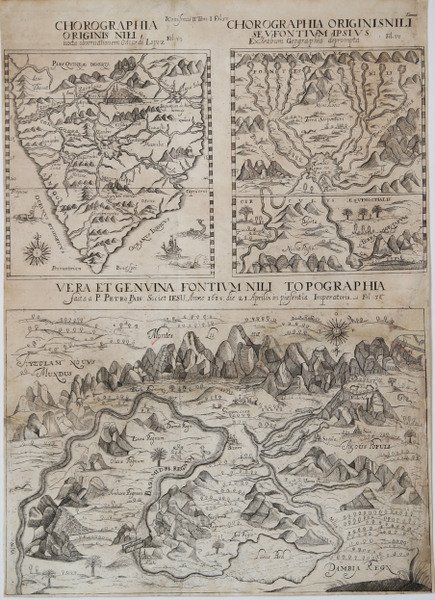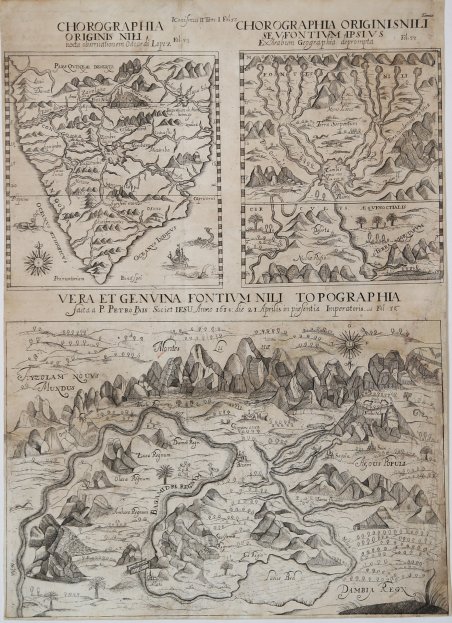Tavola contenente tre mappe su un unico foglio, che fornisce uno studio delle varie teorie della sorgente del fiume Nilo. La prima mappa mostra le informazioni derivate dalle osservazioni fatte dall'esploratore portoghese Duarte Lopes tra il 1578 e il 1584. ' La seconda mappa mostra le informazioni derivate dalle prime fonti cartografiche arabe. La terza mappa (orientata con il sud in alto) mostra le informazioni derivate dal missionario gesuita spagnolo Pedro Paez, tra il 1618 e il 1621, derivate principalmente dalla sua História da Ethiópia, che non sarebbe stata pubblicata in un'edizione stampata fino al 1905-1917. A Paez si attribuisce la scoperta della sorgente del fiume Nilo Azzurro nelle montagne dell'Etiopia (lago Tana). Paez riferì che lì c'erano due "fontane". Athanasius Kircher (1601-1680) era un prete gesuita e uno studioso molto rispettato, noto per il suo ruolo nella diffusione della conoscenza. Kircher fu educato in greco, ebraico e in materie umanistiche a Fulda, Paderborn, Colonia, Coblenza e Magonza. Dopo essere fuggito dalla Guerra dei trent’anni in Germania, Kircher lavorò come accademico ad Avignone e, dal 1634, a Roma. ' A Roma, Kircher servì come nodo intellettuale, diffondendo informazioni inviate da tutto il mondo dai missionari gesuiti. Interessi particolari includevano l'antico Egitto, l'astronomia, la matematica, la medicina, la musica e le lingue (sia antiche che moderne). Fece anche diverse mappe e fu un compilatore geografico. ' Kircher combinò una miscela di ermetismo con la nascente indagine scientifica, guadagnandosi la reputazione di uno degli ultimi uomini del Rinascimento. Per esempio, osservò le eruzioni dell'Etna e dello Stromboli. Si fece calare nel cratere del Vesuvio subito dopo un'eruzione per osservare i cambiamenti prodotti dal cataclisma. Incisione in rame, alcuni restauri al bordo destro e all'angolo inferiore sinistro, altrimenti buone condizioni. Rara. Rare set of 3 maps on a single sheet, providing a study of the various theories of the source of the Nile River. The first map shows the information derived from observations made by the Portuguese explorer Duarte Lopes between 1578 and 1584. ' The second map shows information derived from early Arab cartographic sources. The third map (oriented with south at the top) shows the information derived from the Spanish Jesuit missionary Pedro Paez, between 1618 and 1621, derived primarily from his História da Ethiópia, which would not be published in a printed edition until 1905-1917. Paez is credited with the discovery of the source of the Blue Nile River in the mountains of Ethiopia (Lake Tana). Paez reported that there were two "fountains" there. ' Athanasius Kircher (1601-1680) was a Jesuit priest and a well-respected scholar known for his role in disseminating knowledge. Kircher was educated in Greek, Hebrew, and the humanities at Fulda, Paderborn, Cologne, Koblenz, and Mainz. After fleeing the Thirty Years’ War in Germany, Kircher worked as an academic at Avignon and, from 1634, Rome. ' In Rome, Kircher served as an intellectual node, spreading information sent from around the world by Jesuit missionaries. Particular interests included ancient Egypt, astronomy, mathematics, medicine, music, and languages (both ancient and modern). He also made several maps and was a geographic compiler. It is likely he was the first person to depict the Pacific Ring of Fire on a map. Kircher combined a mixture of hermeticism with nascent scientific inquiry, gaining him a reputation as one of the final Renaissance men. For example, he observed the eruptions of Etna and Stromboli. He had himself lowered into the crater of Vesuvius soon after an eruption to observe the changes wrought by the cataclysm. He experimented with bioluminescence by seeking the applications of firefly extract as a light source. He also made the first known Aeolian harp. ' Kircher wrote 44 books, while over 2,000 of his manuscripts and letters survive. He also assembled one of the first natural history collections, the Museo Kircheriano or the Kircherianum, which was broken up after his death and became the foundation of several institutional collections. Copper engraving, some expert reapirs at the right edge and at the lower left corner, otherwise good condition. Cfr.


Descubre cómo utilizar
Descubre cómo utilizar

